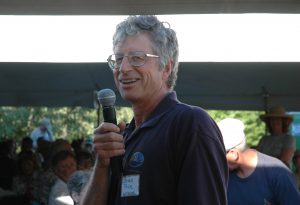 Find your place on the planet, dig in, and take responsibility from there. – Gary Snyder
Find your place on the planet, dig in, and take responsibility from there. – Gary Snyder
This is the last column I will write to you as the Executive Director of the Leelanau Conservancy. As many of you know I am stepping down at the end of this year and turning the helm over to the very capable Tom Nelson.
I think it may be time to speak directly and honestly of my motivations, and the satisfactions that come from a long run as head of an organization that has come to mean so much to so many.
Like Conservancy Founders Ed and Bobbie Collins, I have always been moved by the beauty of the Leelanau landscape. As a pre-teen, my exposure to this area was limited to a week each year spent on Glen Lake in a cottage owned by family friends. During that short summer week, the Leelanau landscape was clearly “imprinted” on me. The sand dune looming at the end of lake, the first opportunity to operate a motorboat by myself, catching a few decent fish – all these things are pure adventure to a 13-year old. Leelanau provided these things and more.
When my family finally bit the bullet and decided to buy a cottage on south Lake Leelanau in 1968 that sense of adventure kicked into high gear. My brother and I took up waterskiing in a serious way, spent innumerable hours exploring without benefit of compass, maps, or sometimes common sense. Who else tried to float down Cedar Run Creek from Alpine Trout Ponds out to Lake Leelanau (after supper no less!)? Who else decided to carry a 14-foot boat around the Leland dam and spend a weekend camping on North Manitou?
For me, the 1970s were a continuation of this exploration; but as a full-time resident I was able to get to know the farming community, meet commercial fishermen both white and Indian, and slowly assemble a broader understanding and appreciation for our Leelanau communities. Susan and I married, and the 1980s became a blur of parenthood, with an opportunity to share this wonderful peninsula with the four new residents we had created.
But Leelanau was rapidly becoming less sleepy by the late 1980s. It was no longer the exclusive province of the locals and the “summer families.” The pressures to develop every buildable lakefront lot, and to cash in on the rising real estate values, were becoming obvious. My increasing familiarity with our peninsula, along with an interest in natural history, revealed that this landscape of great beauty was also a landscape that had not yet recovered from various insults inflicted on it over the past 150 years. Chief among these “legacy costs” were the impact of deforestation in late 1800s and the era of subsistence farming when cattle were encouraged to browse the swamps and forests. To a more practiced eye, the damage was only beginning to heal and would take many more decades. The beauty was there, but so was the damage.
When the Conservancy was formed in 1988, I jumped at the chance to help shape an organization that would make a significant impact in protecting the unique beauty of a place I cared deeply about. The start-up and growth of the Leelanau Conservancy is pretty well documented: carving out a place and establishing an identity within the community, learning to mobilize the resources to protect some of the precious jewels that I explored as a kid, slowly developing and communicating a broader understanding of what the word “stewardship” means in managing some of the peninsula’s most precious lands.
Since the announcement in May of my pending retirement, many of you have offered congratulations and said, in effect, “You must be very satisfied when you see the results of the work done by the Conservancy.” I always acknowledge that sense of satisfaction, together with the observation that there is much left to be done. But I almost never offer more details, or try to explain what is most satisfying in this work, and why I feel so blessed to have been in the right place at the right time. There truly is great satisfaction in the things we have accomplished together. A partial list would include: protecting places of great beauty and quality that I explored in my younger days, helping to bring significant farmland preservation to Leelanau, and applying real conservation science to our peninsula.
There is a deep pleasure in working for an organization that takes concrete action to address sometimes difficult problems. I often tell new board members that I think they will find it totally refreshing to be able identify a problem, construct a solution, assemble the resources, and take action. And the actions that we take, in acquiring land for permanent preservation, and working with landowners to preserve cherished family lands, are forever. There is great satisfaction in doing good work that can’t be undone.
Through all of this I have had Susan at my side, handling much of the administrative responsibility so I could concentrate on strategic goals. A dedicated and seasoned staff paired with a savvy and hard-working board has made my efforts to manage the organization a real pleasure.
Most importantly there is immense satisfaction in bringing Leelanau a little bit closer to being a true “conservation community.” There is a widespread appreciation of our natural inheritance and the bounty of our land that is coupled with an increasing understanding of the magnitude of our “footprint” on this peninsula. Looking back, I think I just wanted to stake some small claim to my place on the planet, and as 60s poet Gary Snyder bluntly put it: “Dig in and take responsibility.” Thank you for giving me that opportunity.



